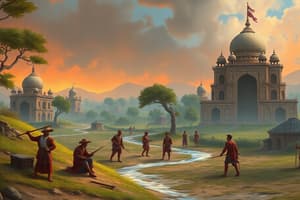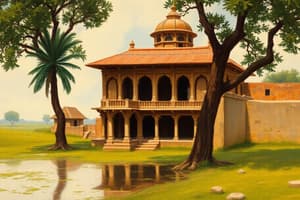Podcast
Questions and Answers
Explain the paradox of resource abundance leading to underdevelopment, particularly in the context of mineral-rich regions. What underlying factors contribute to this phenomenon?
Explain the paradox of resource abundance leading to underdevelopment, particularly in the context of mineral-rich regions. What underlying factors contribute to this phenomenon?
Resource curse occurs due to factors like price volatility, corruption, lack of diversification, and neglecting development of other sectors. This hinders sustainable growth.
Assess the long-term environmental consequences of prioritizing short-term economic gains in industrial development. Provide specific examples to support your answer.
Assess the long-term environmental consequences of prioritizing short-term economic gains in industrial development. Provide specific examples to support your answer.
Deforestation, pollution, and resource depletion are some long-term environmental consequences. The rapid industrialization in China has led to significant air and water pollution.
Critically evaluate the role of the judiciary in safeguarding the fundamental rights of marginalized communities. Explain how judicial activism can both help and hinder this process.
Critically evaluate the role of the judiciary in safeguarding the fundamental rights of marginalized communities. Explain how judicial activism can both help and hinder this process.
The judiciary interprets laws, protects rights, and ensures justice for marginalized communities. Activism can expedite or overstep constitutional boundaries.
Explain the concept of 'ecological footprint' and how it relates to resource consumption patterns in developed versus developing nations.
Explain the concept of 'ecological footprint' and how it relates to resource consumption patterns in developed versus developing nations.
How does the Directive Principles of State Policy influence law-making in India? Explain with reference to environmental protection or social justice.
How does the Directive Principles of State Policy influence law-making in India? Explain with reference to environmental protection or social justice.
Analyze the impact of globalization on traditional agricultural practices and food security in developing countries.
Analyze the impact of globalization on traditional agricultural practices and food security in developing countries.
Discuss the challenges in ensuring equitable access to public facilities in urban slums compared to planned urban areas. What are the key factors contributing to these disparities?
Discuss the challenges in ensuring equitable access to public facilities in urban slums compared to planned urban areas. What are the key factors contributing to these disparities?
Compare and contrast the approaches to addressing social marginalization in India before and after the adoption of the Constitution. How effective have these approaches been?
Compare and contrast the approaches to addressing social marginalization in India before and after the adoption of the Constitution. How effective have these approaches been?
Evaluate the long-term consequences of the Permanent Settlement introduced by the British in India. How did it fundamentally alter agrarian relations and contribute to socio-economic disparities in rural society?
Evaluate the long-term consequences of the Permanent Settlement introduced by the British in India. How did it fundamentally alter agrarian relations and contribute to socio-economic disparities in rural society?
Critically analyze the factors that led to the Revolt of 1857, emphasizing the diverse grievances of different social groups and their contribution to the widespread nature of the uprising.
Critically analyze the factors that led to the Revolt of 1857, emphasizing the diverse grievances of different social groups and their contribution to the widespread nature of the uprising.
Assess the impact of British industrial policies on Indian artisans and industries. How did these policies contribute to deindustrialization and the rise of modern industries in India?
Assess the impact of British industrial policies on Indian artisans and industries. How did these policies contribute to deindustrialization and the rise of modern industries in India?
Compare and contrast the educational philosophies of the colonial education system with the nationalist ideas about education that emerged during the late 19th and early 20th centuries.
Compare and contrast the educational philosophies of the colonial education system with the nationalist ideas about education that emerged during the late 19th and early 20th centuries.
Evaluate the role of women reformers in the social reform movements of the 19th century. How did their contributions challenge societal norms and contribute to the advancement of women's rights?
Evaluate the role of women reformers in the social reform movements of the 19th century. How did their contributions challenge societal norms and contribute to the advancement of women's rights?
Analyze the challenges and achievements of independent India in its early years, focusing on the socio-economic and political factors that shaped the nation's development.
Analyze the challenges and achievements of independent India in its early years, focusing on the socio-economic and political factors that shaped the nation's development.
Explain the concept of sustainable development concerning resource management. How can societies balance the need for resource utilization with the imperative of environmental conservation for future generations?
Explain the concept of sustainable development concerning resource management. How can societies balance the need for resource utilization with the imperative of environmental conservation for future generations?
Assess the impact of human activities on land, soil, water, natural vegetation and wild life resources. How climate change is affecting these resources specifically?
Assess the impact of human activities on land, soil, water, natural vegetation and wild life resources. How climate change is affecting these resources specifically?
Flashcards
What are minerals?
What are minerals?
Naturally occurring substances with definite chemical composition.
What is agriculture?
What is agriculture?
Cultivating land to grow crops and raise livestock for food and other products.
What are industries?
What are industries?
Grouping of businesses that produce goods or services.
What are Human Resources?
What are Human Resources?
Signup and view all the flashcards
What is the Indian Constitution?
What is the Indian Constitution?
Signup and view all the flashcards
What is Secularism?
What is Secularism?
Signup and view all the flashcards
What is Colonialism?
What is Colonialism?
Signup and view all the flashcards
What is Nationalism?
What is Nationalism?
Signup and view all the flashcards
SST Class 8
SST Class 8
Signup and view all the flashcards
Permanent Settlement, Ryotwari, Mahalwari
Permanent Settlement, Ryotwari, Mahalwari
Signup and view all the flashcards
Dikus
Dikus
Signup and view all the flashcards
Revolt of 1857
Revolt of 1857
Signup and view all the flashcards
Geography
Geography
Signup and view all the flashcards
Resources
Resources
Signup and view all the flashcards
Renewable resources
Renewable resources
Signup and view all the flashcards
Non-renewable resources
Non-renewable resources
Signup and view all the flashcards
Study Notes
- SST Class 8 typically refers to Social Science studies for students in the 8th grade.
Resources
- NCERT textbooks for Class 8 Social Science are a primary resource.
- These books cover History, Geography, and Civics (Social and Political Life).
- Additional reference books, sample papers, and online resources can supplement learning.
History (Our Pasts – III)
- The Modern Period in Indian History (from the 18th century onwards) is the focus.
Key Themes
- How, When, and Where: Introduces the importance of dates, periods, and sources in history.
- From Trade to Territory: The establishment and expansion of the East India Company's power.
- Ruling the Countryside: Focuses on land revenue systems such as Permanent Settlement, Ryotwari, and Mahalwari. It also explores the impact of British economic policies on agriculture and rural society, including the indigo rebellion.
- Tribals, Dikus, and the Vision of a Golden Age: Examines the interactions between tribal communities and outsiders (Dikus), as well as tribal revolts.
- When People Rebel: The Revolt of 1857 – causes, events, and consequences.
- Colonialism and the City – The Story of an Imperial Capital: Focuses on urbanization in the colonial period, with a case study of an imperial capital city (often Delhi).
- Weavers, Iron Smelters, and Factory Owners: Impact of British industrial policies on Indian artisans and industries. The rise of modern industries in India.
- Civilising the “Native”, Educating the Nation: Examines the colonial education system and its impact. It also looks at the emergence of nationalist ideas about education.
- Women, Caste, and Reform: Social reform movements addressing issues like Sati, child marriage, and caste discrimination. Role of women reformers.
- The Making of the National Movement: 1870s-1947: The Indian National Congress, the rise of nationalism, different phases of the national movement, and the partition of India.
- India After Independence: The challenges and achievements of independent India in its early years.
Geography (Resource and Development)
- Focuses on resources, their types, distribution, and conservation, as well as economic activities.
Key Themes
- Resources: Definition, types of resources (natural, human-made, human), renewable and non-renewable resources.
- Land, Soil, Water, Natural Vegetation and Wildlife Resources: Importance, distribution, conservation, and management of these resources.
- Mineral and Power Resources: Types of minerals, distribution, uses, and conservation. Conventional and non-conventional sources of power.
- Agriculture: Types of farming, major crops, and agricultural development in different regions.
- Industries: Classification of industries, factors affecting location of industries, industrial regions, and distribution of major industries.
- Human Resources: Population distribution, density, growth, and characteristics.
Civics (Social and Political Life – III)
- Deals with the Indian Constitution, parliamentary system, judiciary, and social justice issues.
Key Themes
- The Indian Constitution: Features, Preamble, Fundamental Rights, and Directive Principles of State Policy.
- Understanding Secularism: What secularism means and why it is important for a country like India.
- Why do we need a Parliament?: Role and functions of the Parliament.
- Understanding Laws: How laws are made, types of laws, and the importance of the rule of law.
- Judiciary: Structure of the Indian judiciary (Supreme Court, High Courts, subordinate courts), role of the judiciary in protecting the Constitution and resolving disputes.
- Understanding Our Criminal Justice System: The roles of the police, public prosecutor, defense lawyer, and judge in the criminal justice system.
- Understanding Marginalisation: Social marginalization and the experiences of marginalized communities in India.
- Confronting Marginalisation: Strategies and mechanisms for addressing marginalization.
- Public Facilities: Importance of public facilities like water, sanitation, health, and education, and the government's role in providing them.
- Law and Social Justice: The role of laws in promoting social justice and protecting the rights of vulnerable groups.
Key Concepts Across Subjects
- Colonialism: Understanding the impact of British rule on Indian society, economy, and polity.
- Nationalism: The rise of nationalist sentiments and the freedom movement.
- Resource Management: Sustainable use and conservation of natural resources.
- Social Justice: Issues of inequality, discrimination, and the role of the state in promoting equality.
- Democracy: Principles and functioning of the Indian democratic system.
Studying That Suits You
Use AI to generate personalized quizzes and flashcards to suit your learning preferences.




